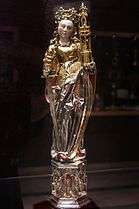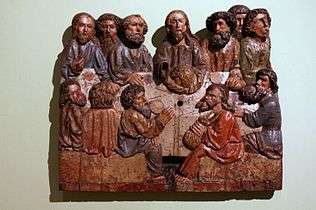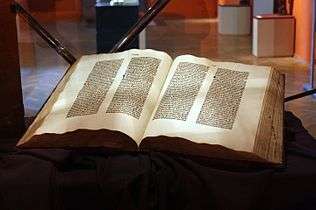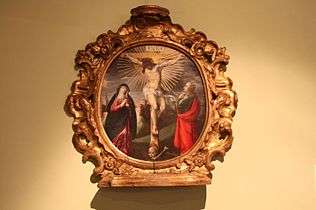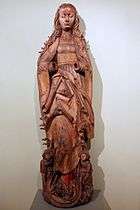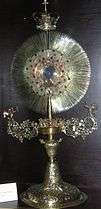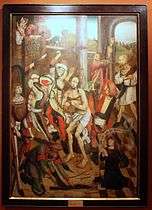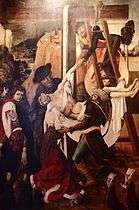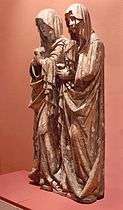Diocesan Museum in Pelplin
The Diocesan Museum in Pelplin (Polish: Muzeum Diecezjalne w Pelplinie) holds one of the finest collections of medieval art in Poland. It is located in the town of Pelplin in Tczew County (Pomeranian Voivodeship) and is managed by the bishopric of the Roman Catholic Diocese of Pelplin. It bears the name of Bishop Stanisław Wojciech Okoniewski (1870–1944), the founder of the museum (pl), who died in Lisbon during World War II. Founded in the Second Polish Republic in 1928 during the interwar period, the collections have been housed in a modern-style building complex since 1988.
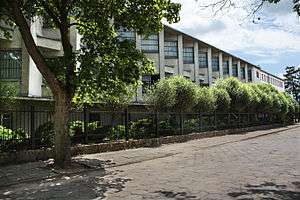 New building of Diocesan Museum (Muzeum Diecezjalne) in Pelplin | |
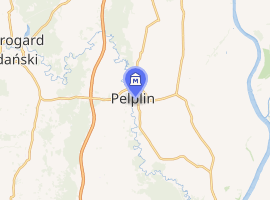
| |
| Established | 1928 |
|---|---|
| Location | Pelplin, Tczew County, Pomeranian Voivodeship, Poland |
| Type | Catholic sacred art |
| Founder | Bishop Stanisław Wojciech Okoniewski |
| Website | www |
Museum collections
The largest part of the collections are Gothic sculptures from the churches of the former Diocese of Kulm renamed in 1925 as the Bishopric of Pelplin, and also from the Roman Catholic Diocese of Toruń. Late Gothic paintings of "Crucifixion" from Lignowy (gilded with gold leaf),[1] "Flagellation" (1380), and "Descent from the Cross" (1495) from the Cathedral Basilica of St. John the Baptist and John the Evangelist in Toruń, are supplemented with original art by Hermann Hahn (1570–1628) and Andreas Stech (1635–1697).[2] The museum received generous financial support from the Ministry of Culture and National Heritage for the preventive conservation of paintings from 1420 to 1695.[3]
The Gutenberg Bible (pictured below) held by the museum,[4] originally from the Franciscan monastery in Lubawa, is one of only 48 copies which survived to modern times. Of those, only 20 are complete; and are worth up to $100 million each.[5] It is one of only nine copies,[6] surviving in its original 15th century binding,[6][4][p. 157] which was added by Henricus Coster of Lübeck.[7] It is printed on both sides of 641 sheets of paper (folios), in two columns measuring 285 mm × 85 mm each, with 40–42 verses, for the total of 1,282 pages of text.[8] Leaves are inserted between some gatherings.[9] During its printing, a loose typesetting sort fell upon a page of this copy and made a mark. This unique feature of the Pelplin Bible enabled scholars to deduce the shape of Gutenberg's type.[10] The binding consists of two beveled oak boards covered in red goat leather, with five brass buttons, corner fittings and buckles fastened to leather straps.[11] The Bible from Pelplin was rescued during World War II by the Polish government,[6] and came to Canada through Paris and London. Kept in a vault at the Bank of Montreal in Ottawa,[6] it was not returned to Poland until 1959.[8]
The museum collections of early prints include the priceless manuscript of St. Augustine of Hippo from 1425 titled "De civitate Dei".[12] The collections of the venerated objects of piety contain monstrances and reliquaries from the workshops of Gdańsk, Toruń, and Nuremberg. The collections also include liturgical garments, such as vestments and dalmatics.[13]
Gallery
Notes
- Muzeum Diecezjalne (2017). "Obraz gotycki z Kościoła w Lignowach". Pelplin.
- Muzeum Diecezjalne (2017), Sztuka Średniowiecza. Sztuka Nowożytna. Pelplin.
- Muzeum Diecezjalne (5 July 2016). "Konserwacja kilkunastu unikatowych obrazów z lat 1420–1695 oraz ich digitalizacja". Pelplin.
- Gordon Swoger (2004). The Strange Odyssey of Poland's National Treasures, 1939–1961. Dundurn. pp. 50, 77, 156–157. ISBN 1554880262 – via Google Books.
- Charlie Kirk (2016). Time for a Turning Point: Setting a Course Toward Free Markets and Limited Government for Future Generations. Post Hill Press. p. 108. ISBN 1682612481 – via Google Books.
No auction has been held in years but if one were to be sold, say at Christie's Auction House in New York, it is speculated that it could fetch as much as $100 million.
- Jonathan Rose (2008). The Holocaust and the Book: Destruction and Preservation. Univ of Massachusetts Press. pp. 144, 147–148. ISBN 1558496432 – via Google Books.
- Jan Pirożyński (2005). Early Imprints from the Gutenberg Press in the Jagiellonian Library (PDF). Foreign Collections in Polish Libraries Today. Vol. 6. Warsaw: The National Library. p. 32 (31 of 131 in PDF) and pp. 120–121 in "Review" by Andrzej Tomaszewski. ISSN 0867-6976. Gutenberg produced 36-line, 40-line, and 42-line bibles over time.
It seems obvious that Gutenberg did not commence his printing activities by publishing the 42-line Bible, a work of as many as 643 leaves.
- Muzeum Diecezjalne (2017). "Biblia Gutenberga" [The Gutenberg Bible]. Pelplin.
Google translate.
- The British Library (2017). "Gutenberg Bible: The Gatherings". Background. Leaves inserted between gatherings are not consistent. Twelve surviving copies of the Bible include as many as 643 folios with additional sheets inserted after leaves 4, 7, 8 and 9 in the first volume; and leaves 3, 7 and 10 in the second volume. See also:
——. "Composition and presses". Treasures in Full.CS1 maint: numeric names: authors list (link)
——. "The types". Treasures in Full.CS1 maint: numeric names: authors list (link)
——. "The ink". Treasures in Full.CS1 maint: numeric names: authors list (link)
——. "How many". Treasures in Full.CS1 maint: numeric names: authors list (link) - Sutter, Sem (2008), "The Treasures of Pelplin", The Holocaust and the Book, University of Massachusetts Press, p. 144, ISBN 9781558496439
- "The Gutenberg Bible. The Most Revolutionary Book in History" (PDF). Codices Illustres. A Resource for Libraries and Institutions. Montale Rangone (MO), Italy. p. 7 (7 of 9 in PDF). "The Pelplin Specimen and its Story" – via direct download 1,6 MB.
- Diecezjalne Centrum Informacji Turystycznej (2017). "Szlak Cysterski w Polsce". Pelplin: Obiekty cysterskie. [Also in:] Kasia & Maciej Marczewscy (25 February 2015). "Biblioteka Diecezjalna w Pelplinie – wizyta w krainie starodruków" [Pelplin Diocesan Bibliotheque]. "Pelplin i jego zabytki" by Janusz St. Pasierb. Ruszaj w Drogę!.CS1 maint: uses authors parameter (link)
- Muzeum Diecezjalne w Pelplinie (2017). "Tkaniny" [Liturgical garments]. Pelplin. Retrieved 5 March 2017.
References
- Muzeum Diecezjalne, Historia. Pelplin.
- Muzeum Diecezjalne, Sztuka Średniowiecza. Pelplin.
- Muzeum Diecezjalne, Sztuka Nowożytna. Pelplin.
- Muzeum Diecezjalne, Tkaniny. Pelplin.
- Muzeum Diecezjalne, Skarbiec. Pelplin.
- Muzeum Diecezjalne, Biblia Gutenberga. Pelplin.
- Muzeum Diecezjalne, Pracownia Konserwatorska. Pelplin.
- Culture.pl, Muzeum Diecezjalne w Pelplinie.
- Ks. Robert Kaczorowski, Akademia Muzyczna, Gdańsk (2009). ks. Adam Świeżyński (ed.). "Msze per annum (I-V) ze „Zbioru pieśni nabożnych katolickich do użytku kościelnego i domowego" opublikowanego w 1871 roku w Pelplinie" (PDF). STUDIA GEDANENSIA. Gdańsk-Oliwa: Gdańskie Seminarium Duchowne. pp. 253–264 (239–250 in PDF). ISSN 0137-4338.CS1 maint: multiple names: authors list (link)
Further reading
- Roman Ciecholewski: Skarby Pelplina, Wydaw. Diecezjalne, Pelplin 1997, ISBN 8385087524.
- Roman Ciecholewski: Quis ut Deus. Treasures from the Diocesan Museum Pelplin. Art at the time of the Teutonic Order: Nordostdeutsches Kulturwerk, Lüneburg, 2000; ISBN 3932267273.
- Bogna Derkowska-Kostkowska, Szczepan Warmijak: Gotycka rzeźba pomorska i starodruki z XV wieku ze zbiorów Muzeum Diecezjalnego i Biblioteki Diecezjalnej w Pelplinie (Gothic Pomeranian Sculpture and Early Prints), Muzeum Okręgowe in the. Leona Wyczółkowskiego w Bydgoszczy, Bydgoszcz, MO, 1992.
External links

